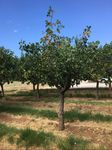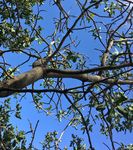Verticillium Wilt of Pistachio - Cooperative Extension
←
→
Page content transcription
If your browser does not render page correctly, please read the page content below
az1930 May 2021
Verticillium Wilt of Pistachio
Jiahuai Hu
Introduction
Verticillium wilt is a common vascular wilt disease of
many economically important crops. The disease was
first identified in pistachio in California in 1970s and
historically has been a serious problem of pistachio. With
the introduction of resistant rootstocks, the significance
of Verticillium wilt has diminished greatly in the US. In
Arizona, Verticillium wilt can be a significant problem of
older pistachio trees on susceptible rootstocks (Pistacia
atlantica and P. terebinthus) in Cochise county. The disease
often is lethal to trees and tree death causes significant
yield loss and incurs high replanting costs.
Pathogens
Verticillium dahliae (fungus: Ascomycetes).
Host Range:
Verticillium wilt affects numerous herbaceous and
woody plant species. Important hosts in Arizona include:
1) vegetables: cucurbits, chile pepper, eggplant, and potato;
2 ) fruit nut trees: pistachio, olive, almond, strawberries
and raspberries; 3) agronomic crops: cotton and alfalfa;
and 4) landscape plants: rose, elm, and maple.
Disease Cycle: Leaf scorching on a pistachio tree affected by Verticillium wilt
The fungus survives as microsclerotia in the soil for many
years, especially when previous soils have been planted
to the soil for repeated infections or survival. The fungus
with susceptible crops such as cotton, alfalfa, and cucurbits
are spread by contaminated soils and nursery stocks as
prior to orchard establishment. Microsclerotia germinate in
well as pruning tools.
the vicinity of actively growing roots and produce hyphae
to infect roots. The fungus invades the xylem vessels of
roots and leads to systemic infection of vascular system
Symptoms and Diagnosis:
of the tree. Prolific fungal growth in the xylem channels Pistachio trees of any age are susceptible. First
restricts or disrupts the flow of water and nutrient. Disease leaf symptoms on affected branches are interveinal
development is favored by cold temperature, wet soil chlorosis and yellowing, followed by drying with a
and stressed tree conditions. Hot summer may inactivate scorched appearance. The affected leaves fall off, leaving
the fungus in aboveground portions and re-infections the branches barren. In late spring or summer, high
from roots may occur as favorable conditions return. temperature often leads to rapid wilting of one or more
Microsclerotia are produced in infected tree and returned scaffold branches or death of the entire tree within asingle season. In some cases, the disease can be chronic Management
and causes a tree disorder called “thin leaf decline” where
The most effective tool to manage verticillium wilt is to
slow branch dieback with a gradual canopy thinning, replace the susceptible rootstocks (Pistacia atlantica and
and reduced tree vigor and yield is the typical symptoms P. terebinthus) with the resistant rootstock Pioneer Gold
from season to season. Symptom expression varies with a (P. integerrima), PG II or UCB I (P. integerrima x P. atlantica
specific rootstock and scion combination, inoculum density hybrid). The occurrence and severity of verticillium wilt
in the soil, disease severity, and environmental conditions. may be reduced by reducing tree stresses and maintaining
The diagnostic symptom is the vascular staining of branch, tree health via proper management of irrigation and
stem and root, but may not always be present. nutrients. Avoid planting trees in infested fields with a
crop history of cotton, alfalfa and cucurbits. Pre-plant Soil
Conditions can be confused with: fumigation and solarization may reduce microsclerotia
populations within the soil, but will not eradicate the
Cotton (Texas) root rot or Phymatotrichopsis root rot, fungus.
Phytophthora crown rot. Verticillium wilt does not exhibit
rots of root or crown, but has a distinct vascular staining in Additional Resources
xylem of root, stem and branch. For a definitive diagnosis,
symptomatic tissues should be collected and wrapped in Raabe, R.D. and Wilhelm, S. 1978. Susceptibility of
a dry paper towel, placed in a plastic bag, and shipped several Pistacia species to Verticillium albo-atrum. Plant Dis.
overnight to the University of Arizona’s Extension Plant Rptr. 62:672-673
Pathology laboratory in Tucson. All submissions should Holtz B., Teviotdale B.L., and Epstein L. 2016. Soil-borne
be accompanied by completed Plant Disease Diagnostic diseases in Pistachio Production Manual (L. Ferguson and
Form. D.R. Haviland Ed.) University of California Agriculture
and Natural Resources Publication 3545, 257-264
Dark brown staining of xylem tissues in a branch Thin leaf decline of a tree infected with Verticillium wilt
2 The University of Arizona Cooperative ExtensionSee-through canopy associated with thin leaf decline Slow twig dieback over several seasons
Rapid death of one scaffold branch Rapid death of all but one scaffold branch
The University of Arizona Cooperative Extension 3Lower areas of orchards with several tree fatality, trees located at the leading edge of infection continue to decline gradually (note dead trees
in the center were replaced with young trees with resistance to Verticillium wilt )
Bark crack or death on a tree with severe symptoms of Verticillium wilt
AUTHORS
Dr. Jiahuai Hu
Assistant Cooperative Extension Specialist and Plant Pathologist,
School of Plant Sciences
CONTACT
Jiahuai Hu
epp@email.arizona.edu
This information has been reviewed
by University faculty.
extension.arizona.edu/pubs/az1930-2021.pdf
Other titles from Arizona Cooperative Extension
Death of a pistachio tree affected by Verticillium wilt can be found at:
extension.arizona.edu/pubs
Any products, services or organizations that are mentioned, shown or indirectly implied in this publication do not imply endorsement by The University of Arizona.
Issued in furtherance of Cooperative Extension work, acts of May 8 and June 30, 1914, in cooperation with the U.S. Department of Agriculture, Jeffrey C. Silvertooth, Associate Dean & Director, Extension
& Economic Development, Division of Agriculture, Life and Veterinary Sciences, and Cooperative Extension, The University of Arizona.
The University of Arizona is an equal opportunity, affirmative action institution. The University does not discriminate on the basis of race, color, religion, sex, national origin, age, disability, veteran status,
sexual orientation, gender identity, or genetic information in its programs and activities.
4 The University of Arizona Cooperative ExtensionYou can also read



























































